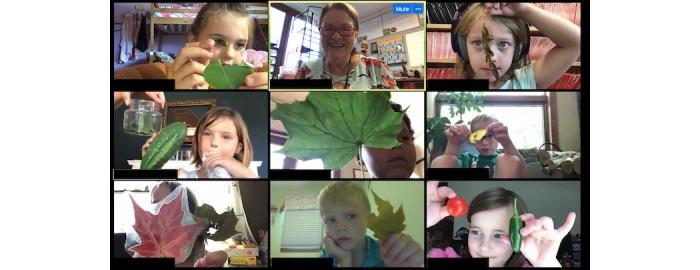
When the nation shut down last year and students and teachers were abruptly prevented from being in classrooms together, it was a serious blow on every level – to teachers’ workload and planning, to students’ socialization and education progress and a thousand other ways.
As the months wore on and teachers adapted to online instruction, some of those challenges were solved. The intangible necessity of creating the feeling of community over iPads and laptops, however, was a tricky issue to address.
Jodi White, who teaches both a kindergarten and a first-grade class virtually, had to rethink the way she builds the feeling of belonging in little ones who were used to the personal touch. Before the pandemic, White said she used hugs, high fives and handshakes to build relationships with her kids.
Now, she relies on keeping the structure of the virtual classroom so students feel comfortable.
“Predictability is security for young children. They need to know what to expect and what is coming next,” she said. “But the most important part of building those relationships with young kids happens in our morning meeting and closing circle. These meetings are all about talking with kids. It is where I teach them that we are now a classroom family and how family helps each other through the good and difficult things in life,” she said.
Another major change in the way White builds community in her classrooms this year is the always-vital role parents play in education, she said. That means striving to make online classes as smooth as possible for parents, cutting down on as much stress as she can, and finding ways to support parents as they learned the technology necessary for their kids to participate in class.
“I had to think about how do I get the support from parents and how do I support them?” White said. “I created a lot of instruction videos modeling how to do things on the iPad for parents. I found ways for parents to volunteer remotely.”
For instance, White said, parents volunteer to read aloud in both kindergarten and first grade storytimes, and younger siblings are also welcome. One parent used her art education background to make art project videos for White’s students.
“It is extremely important that students feel they are a part of a class and school,” White said. “I cannot tell you how often my young students share in celebrations or appreciations that they are able to be together in a class.”
Nicholas Scharenbroch, a fourth- and fifth-grade multiage classroom teacher, had different challenges for his older students, including finding new ways to build that feeling of kinship that’s so important.
The technology necessary for virtual learning has actually helped in this regard, he said, because when he’s working with a small group of students in a breakout room, he can focus on them instead of splitting his attention between the small group and everybody else.
And he’s seen some very positive results of virtual learning
“They are more engaged and excited about the small things,” he said. “It is easier to get into a rut and stay the course, so anytime we do anything different, they get super jazzed about it. The quality and quantity of work that is being turned in has gotten progressively better.”
Scharenbroch said that no matter how students are learning, feeling like a member of the classroom is vital – both for the students themselves and the school as a whole.
“I think that they need to still understand that they are an integral part of building the culture of our school,” he said. “The difference between our school and others that I have been to is that we allow the students to be part of molding what our schools look and feel like instead of telling them what we expect of them.”
That working-together mindset is one of the things that sets Etude apart from other schools in the district, and Scharenbroch takes his students’ needs and feelings seriously.
“Building these relationships has taken more work, whether it's morning meetings, hanging during their lunch break, or even meeting up for activities outside (beach cleanup/taking hikes),” he said. “Overall, I feel like the class has really become a place where students are able to share their thoughts and feelings without the fear of judgment that might happen in other places in their lives.”

